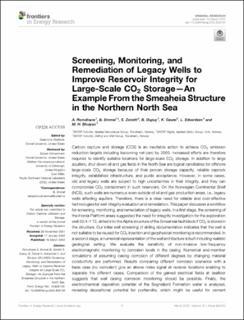| dc.contributor.author | Romdhane, Mohamed Anouar | |
| dc.contributor.author | Emmel, Benjamin | |
| dc.contributor.author | Zonetti, Simone | |
| dc.contributor.author | Dupuy, Bastien | |
| dc.contributor.author | Gawel, Kamila | |
| dc.contributor.author | Edvardsen, Laura | |
| dc.contributor.author | Bhuiyan, Mohammad Hossain | |
| dc.date.accessioned | 2022-08-09T10:29:01Z | |
| dc.date.available | 2022-08-09T10:29:01Z | |
| dc.date.created | 2022-04-24T16:01:31Z | |
| dc.date.issued | 2022 | |
| dc.identifier.citation | Frontiers in Energy Research. 2022, 10 1-17. | en_US |
| dc.identifier.issn | 2296-598X | |
| dc.identifier.uri | https://hdl.handle.net/11250/3010761 | |
| dc.description.abstract | Carbon capture and storage (CCS) is an inevitable action to achieve CO2 emission reduction targets including becoming net-zero by 2050. Increased efforts are therefore required to identify suitable locations for large-scale CO2 storage. In addition to large aquifers, shut down oil and gas fields in the North Sea are logical candidates for offshore large-scale CO2 storage because of their proven storage capacity, reliable caprock integrity, established infrastructure, and public acceptance. However, in some cases, old and legacy wells are subject to high uncertainties in their integrity, and they can compromise CO2 containment in such reservoirs. On the Norwegian Continental Shelf (NCS), such wells are numerous even outside of oil and gas production areas, i.e., legacy wells affecting aquifers. Therefore, there is a clear need for reliable and cost-effective technologies for well integrity evaluation and remediation. This paper discusses a workflow for screening, monitoring, and remediation of legacy wells. In a first stage, the screening of the Horda Platform areas suggested the need for integrity investigation for the exploration well 32/4-1 T2, drilled into the Alpha structure of the Smeaheia fault block if CO2 is stored in the structure. Our initial well screening of drilling documentation indicates that the well is not suitable to be reused for CO2 injection and geophysical monitoring is recommended. In a second stage, a numerical representation of the well architecture is built including realistic geological setting. We evaluate the sensitivity of non-invasive low-frequency electromagnetic monitoring to corrosion levels in the casing. Numerical end-member simulations of assuming casing corrosion of different degrees by changing material conductivity are performed. Results comparing different corrosion scenarios with a base case (no corrosion) give an above noise signal at receiver locations enabling to separate the different cases. Comparison of the gained electrical fields at seafloor suggests that well casing corrosion monitoring should be possible. Finally, the electrochemical deposition potential of the Sognefjord Formation water is analyzed, revealing depositional potential for portlandite, which might be useful for cement remediation. We recommend such an analysis for all legacy wells penetrating candidate reservoirs for future CO2 or hydrogen storage. | en_US |
| dc.language.iso | eng | en_US |
| dc.publisher | Frontiers | en_US |
| dc.rights | Navngivelse 4.0 Internasjonal | * |
| dc.rights.uri | http://creativecommons.org/licenses/by/4.0/deed.no | * |
| dc.subject | geochemistry | en_US |
| dc.subject | numerical modeling | en_US |
| dc.subject | geophysical monitoring | en_US |
| dc.subject | plugging and abandonment | en_US |
| dc.subject | CO2 storage | en_US |
| dc.title | Screening, Monitoring, and Remediation of Legacy Wells to Improve Reservoir Integrity for Large-Scale CO2 Storage—An Example From the Smeaheia Structure in the Northern North Sea | en_US |
| dc.title.alternative | Screening, Monitoring, and Remediation of Legacy Wells to Improve Reservoir Integrity for Large-Scale CO2 Storage—An Example From the Smeaheia Structure in the Northern North Sea | en_US |
| dc.type | Peer reviewed | en_US |
| dc.type | Journal article | en_US |
| dc.description.version | publishedVersion | en_US |
| dc.rights.holder | © 2022 Romdhane, Emmel, Zonetti, Dupuy, Gawel, Edvardsen and Bhuiyan. This is an open-access article distributed under the terms of the Creative Commons Attribution License (CC BY). The use, distribution or reproduction in other forums is permitted, provided the original author(s) and the copyright owner(s) are credited and that the original publication in this journal is cited, in accordance with accepted academic practice. No use, distribution or reproduction is permitted which does not comply with these terms. | en_US |
| dc.source.pagenumber | 1-17 | en_US |
| dc.source.volume | 10 | en_US |
| dc.source.journal | Frontiers in Energy Research | en_US |
| dc.identifier.doi | 10.3389/fenrg.2022.826100 | |
| dc.identifier.cristin | 2018708 | |
| dc.source.articlenumber | 826100 | en_US |
| cristin.ispublished | true | |
| cristin.fulltext | original | |
| cristin.qualitycode | 1 | |

